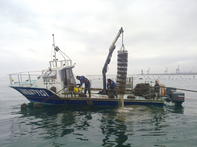Historic methods of oyster farming started with the collection of wild oyster seed and transferring them to production areas. Oyster farming methods have evolved over time to include suspended (hanging culture) and off-bottom methods, using both wild oyster seed as well as hatchery-cultivated oyster seed.

Modern oyster farming methods, include the selection of superior seed stock, and the production of triploid seed in special hatcheries. Selection programmes focus on producing fast-growing seed stock. Triploid oysters have three sets of chromosomes, which makes them sterile and results in fast growth. The meat quality is excellent and oysters can be harvested all year.
In South Africa, the most commonly used species for oyster farming is the Pacific oyster, Crassostrea gigas, produced in offshore longline oyster farming systems, where seed oysters are grown in nets suspended from longlines attached to mooring points.
Offshore Oyster Farming
Algoa Bay in Port Elizabeth and Saldanha Bay are currently being used for longline oyster farming in South Africa. Saldanha Bay is considered more suitable, due to better accessibility, faster growth rate and more consistent phytoplankton levels.
Land-based Oyster Farming
A feasibility study ‘Oyster and Mussels in South Africa’, prepared by Advance Africa Management Services for the Department of Agriculture, Forestry and Fisheries (DAFF) in 2017, has found optimal areas for land-based oyster farming, mostly on the West Coast of South Africa.
It suggested pond culture to the north of Saldanha Bay at Kleinsee, St Helena Bay and Paternoster. In these areas, abandoned mining dams and salt works are suitable for oyster nurseries, but due to its height above sea level, pumping costs may be prohibitively expensive.
Estuary Oster Farming
Oyster farming in estuaries, such as in the Knysna Lagoon, is restricted by law, due to the fact that these sites are used by fish for spawning and thereby are important in restocking fish reserves.
Langebaan Lagoon is suitable for oyster farming, and oysters are farmed in a government facility at Hamburg in the Keiskamma Estuary, using oyster racks.
By Marinda Louw